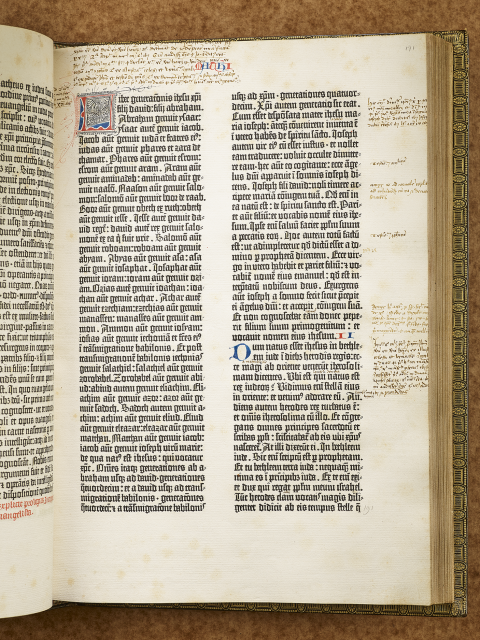
Biblia Latina
Mainz, Germany: Johannes Gutenberg, 1455
Rare Book Division
The presentation of the Gutenberg Bible is made possible by the generosity of Barbara D. Cates and the Carmelo V. Spadafore Trust.
Biblia Latina
Transcript below
Narrator: Biblia Latina, printed by Johannes Gutenberg. Commonly referred to as the Gutenberg Bible. 1455. Printed book with hand-inked initials. About 1 foot 4 inches high by 2 feet wide when displayed open.
The book is displayed open to show closely printed text in Latin on both pages.
Each page of text is printed in two columns. Each column appears as a single vertical block, not indented either at left or right. There are spacious margins surrounding the columns.
Illustrations and illuminations have been added by hand, using mainly red and some blue ink. This sometimes takes the form of a few lines of text in red at the start of a section, or an enlarged and decorated capital letter in red or blue.
This book is one of two volumes of the Bible, comprising a total of nearly 1,300 pages.
Interpretive commentary follows.
Anna Deavere Smith: The world’s oldest known printed book comes from 9th-century China. Yet, for centuries after that, most books were still written and copied by hand. It wasn’t until the mid-15th century that the use of movable type became widespread, and the Gutenberg Bible—the first substantial book printed in Europe—heralded a radical shift in the way the world communicated.
At first glance, the Gutenberg Bible doesn’t look very different from the handwritten manuscripts that came before it. The dense Gothic typeface mimicked the common handwriting style of scribes in what is now Germany. Even the decorated, or rubricated, initial letters were a holdover from earlier manuscript traditions.
But the ability to produce multiple copies of a single book quickly and efficiently? That was revolutionary. Michael Inman is Curator of Rare Books here at the Library.
Michael Inman: With the mass production of identical texts, you now had the opportunity for individuals in different places to be reading the same text at the same time, essentially, which promoted a conversation among readers and scholars. Individuals were able to debate the same ideas, in the same language, essentially.
And at the same time you begin to see language itself being codified—the grammar and syntax of language.
Anna Deavere Smith: That in turn contributed to stronger bonds of national identity.
Michael Inman: When people are speaking the same language, when they identify with one another, they band together. And so what you begin to see in the wake of Gutenberg, in the centuries that follow, is the formation of modern Europe.
End of Transcript
Michael Inman is Curator of Rare Books at The New York Public Library’s Stephen A. Schwarzman Building. We gratefully acknowledge the editorial guidance of Dr. Eric Marshall White of Princeton University.
No copyright: United States